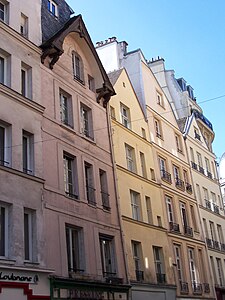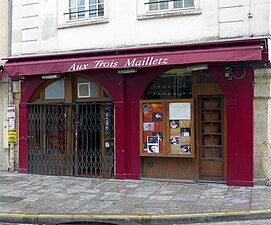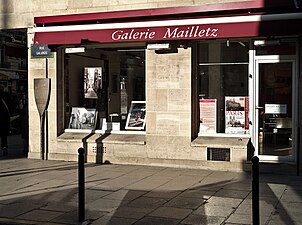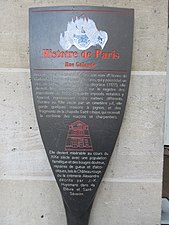Rue Galande
Coordinates: 48 ° 51 ' N , 2 ° 21' E
| Rue Galande | |
|---|---|
| location | |
| Arrondissement | 5. |
| quarter | Sorbonne |
| Beginning | Rue des Anglais |
| The End | Rue Saint-Jacques |
| morphology | |
| length | 165 m |
| width | 12 m |
| history | |
| Emergence | 1202 |
| Original names | Rue Garlande Rue de Gallande |
| Coding | |
| Paris | 3926 |
The Rue Galande is a street in the Quartier de la Sorbonne of the 5th arrondissement in Paris .
Course and access
It starts at rue des Anglais no.2 and rue Lagrange no.10, and ends after 165 meters at rue Saint-Jacques no.1 and rue du Petit Pont no.17.
At its western end, it turns into Rue Saint-Sévérin. Rue Lagrange at its eastern end has only been around since 1887, until then the part of Rue Lagrange between Rue Galande and Place Maubert also belonged to Rue Galande.
This street looks medieval today: with its curved route, narrow sidewalks, paving and medieval buildings. It is a tourist place in the Saint-Michel quarter with many restaurants.
You can reach the street with the Métrolinie 10 , Maubert - Mutualité station .
Name origin
The name goes back to the homestead of those von Garlande ( French clos de Garlande ) who owned a vineyard here and were favorites of Louis VI. were.
history
The name Rue Galande has been documented since 1262 , but the road is probably part of the old Gallo-Roman road from Lutetia to the southeast, on the left bank up the Seine, to the Abbey of Sainte-Geneviève and to Burgundy - this is only secured from Place Maubert. It branched off from Rue Saint Jacques, the southern part of the Roman Cardo , and went to Place Maubert
- on the one hand into the Rue Sainte-Geneviève, which left the city at the Porte Bordelle, then became the Rue Mouffetard , which already then (as today as Route nationale 7) forms the beginning of the road to Lyon;
- on the other hand in the Rue Saint-Victor, which a little further east led to the Porte Saint-Victor and the monastery of Saint-Victor , to Ivry-sur-Seine and Vitry-sur-Seine .
The name was also spelled Rue Garlande, at times the street was also called Rue du Clos Mauvoisin. The confluence of the Rue Galande in the Place Maubert was abolished in 1887 with the construction of the Rue Lagrange.
Rue Galande takes its name from the Clos de Galande, a vineyard that it passed along. The Clos du Galande was owned by the Garlande family and was parceled out after the fall of St. Stephen of Garlande ( 1127 ). After that it developed into a shopping street : In 1292 there are 50 companies from 16 trades.
Attractions
This street is home to some of the last medieval buildings in Paris.
Detail of house no. 31 ( Monument historique ); the wooden gable dates from around 1480.
- House no. 42: Studio Galande , a cinema , the films such. B. The Rocky Horror Picture Show (first performed in 1975) shows. On the left facade, a stone slab embedded in the wall shows an episode from the life of Julianus Hospitator ; this bas- relief , which was mentioned as early as 1380, has been declared a monument historique .
Studio Galande House No. 42 with the relief at the entrance
The relief represents an episode from the life of Julianus Hospitator .
- House number 56: Aux Trois Mailletz dance and jazz club ; there is an orientation board on the side that explains the history of the street.
House number 56, Club Aux Trois Mailletz
Gallery Mailletz with orientation board
- House number 79: The Syrian clergyman Joseph Nasrallah lived here from 1964 to 1993. A plaque reminds of this.
- Other people who lived on the street:
- Balthazar Martinot the Elder (1636-1714), a member of the famous watchmaking dynasty Famille Martinot , settled in 1683 on Rue Galande
- Jean-Georges Wille (1715–1808), German engraver, lived from 1737 to 1742 in a small room on Rue Galande, next door to his compatriot and friend Georg Friedrich Schmidt (1712–1775), who is also an engraver
literature
- Jacques Hillairet and Pascal Payen-Appenzeller, administratif et historique des rues de Paris et de ses monuments , Édition 8, Éditions de Minuit , Paris, 1985. Vol. 2, I, ISBN 2707310549
- Félix et Louis Lazare, Dictionnaire administratif et historique des rues de Paris et de ses monuments , 1844 ( BnF , FRBNF32357628 , fr.wikisource.org )
Web links
- Extrait de la nomenclature officielle des voies de Paris ( Memento of July 16, 2006 in the Internet Archive )
- Rue Galande on Google Maps
Individual evidence
- ^ Félix et Louis Lazare, Dictionnaire administratif et historique des rues de Paris et de ses monuments , Édition de 1844, p. 243
- ↑ a b Jacques Hillairet , Dictionnaire historique des rues de Paris , Vol. 1, 1997, p. 565
- ↑ Rodolphe Trouilleux, Paris secret et insolite , Éditions Parigramme ISBN 9782840969693 , p. 55
- ↑ Balthazar Martinot (biographical details) in the database of the British Museum : read here (en)
- ^ François Courboin , L'Estampe française , Bruxelles et Paris, Librairie d'art et d'histoire, G. van Oest, 1914









